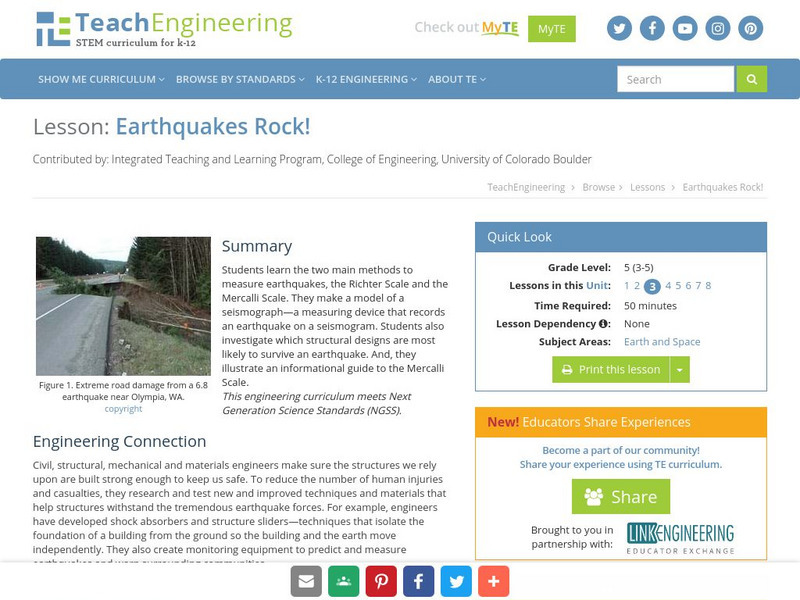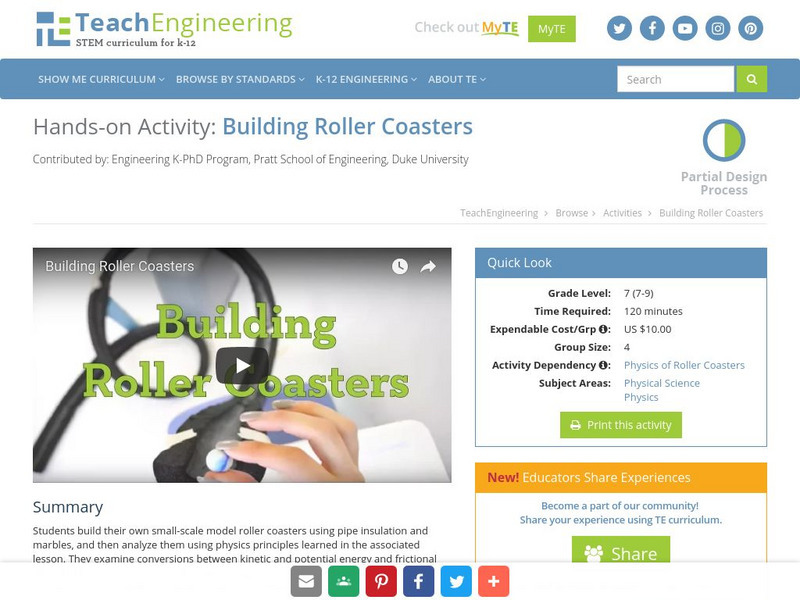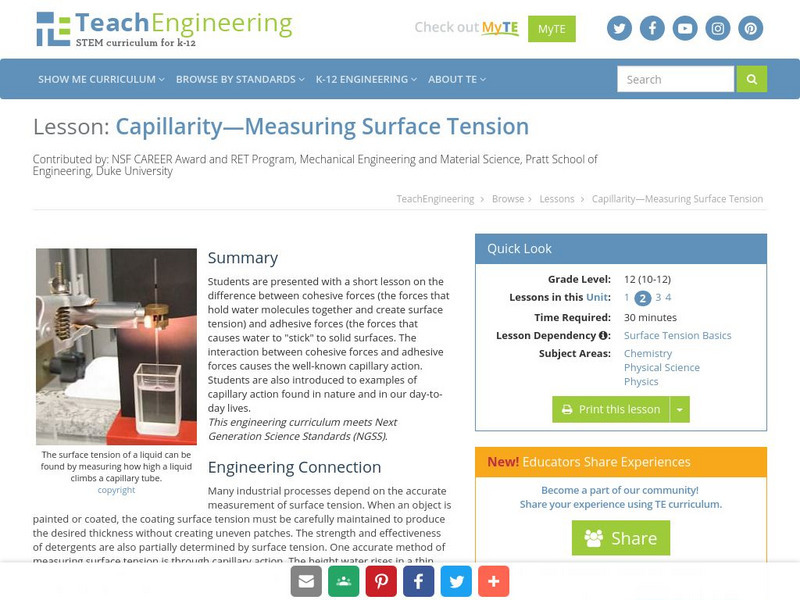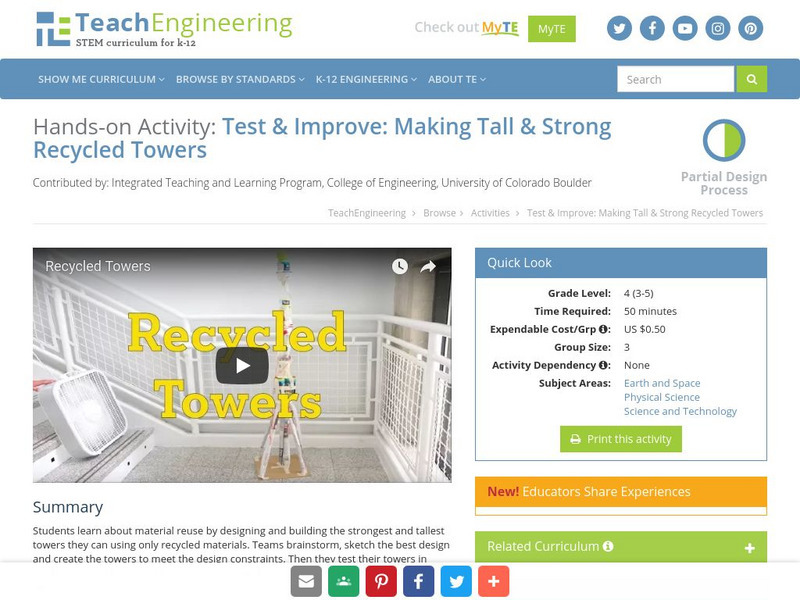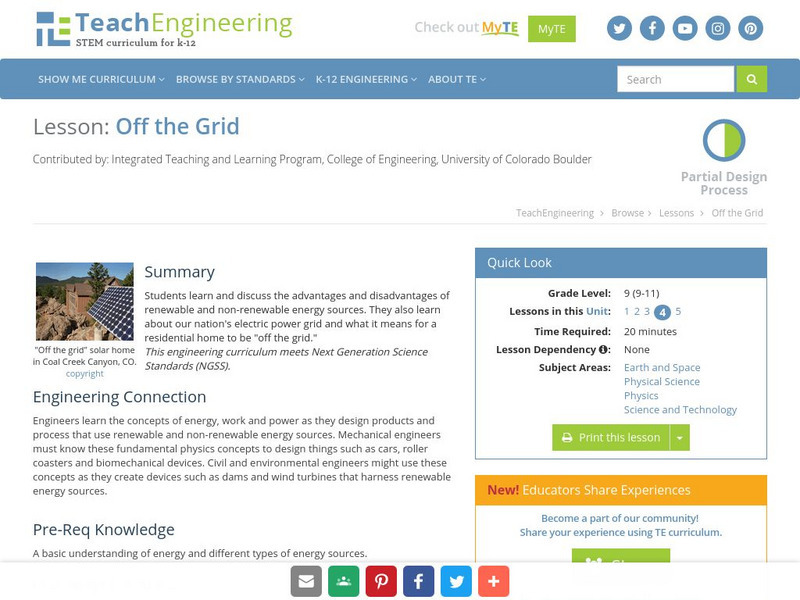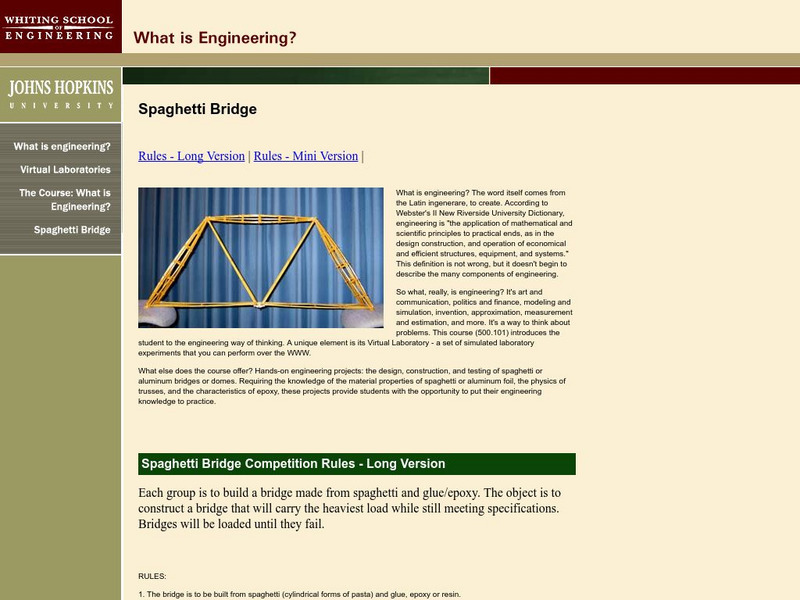TeachEngineering
Teach Engineering: Strong as the Weakest Link
To introduce the two types of stress that materials undergo - compression and tension - students examine compressive and tensile forces and learn about bridges and skyscrapers. They construct their own building structure using...
TeachEngineering
Teach Engineering: Earthquakes Rock!
Learners learn the two main methods to measure earthquakes, the Richter Scale and the Mercalli Scale. They make a model of a seismograph - a measuring device that records an earthquake on a seismogram. Students also investigate which...
TeachEngineering
Teach Engineering: Building Roller Coasters
In this hands-on activity students learn about the laws of physics by creating a marble roller coaster.
TeachEngineering
Teach Engineering: Testing Fundamental Loads
Students will conduct several simple lab activities to learn about the five fundamental load types that can act on structures: tension, compression, shear, bending, and torsion. In this activity, students break foam insulation blocks by...
TeachEngineering
Teach Engineering: Capillarity Measuring Surface Tension
Students are presented with a short lesson on the difference between cohesive forces (the forces that hold water molecules together and create surface tension) and adhesive forces (the forces that causes water to "stick" to solid...
TeachEngineering
Teach Engineering: Recycled Towers
Students learn about material reuse by designing and building the strongest and tallest towers they can, using only recycled materials. They follow design constraints and build their towers to withstand earthquake and high wind simulations.
TeachEngineering
Teach Engineering: Does Media Matter? Infiltration Rates and Storage Capacities
Students gain a basic understanding of the properties of media- soil, sand, compost, gravel- and how these materials affect the movement of water (infiltration/percolation) into and below the surface of the ground.
TeachEngineering
Teach Engineering: Off the Grid
Learners learn and discuss the advantages and disadvantages of renewable and non-renewable energy sources. They also learn about our nation's electric power grid and what it means for a residential home to be "off the grid."
TeachEngineering
Teach Engineering: All About Water!
Students learn about the differences between types of water (surface and ground), as well as the differences between streams, rivers and lakes. Then, they learn about dissolved organic matter (DOM), and the role it plays in identifying...
TeachEngineering
Teach Engineering: Rocks, Rocks, Rocks
Students test rocks to identify their physical properties (such as luster, hardness, color, etc.) and classify them as igneous, metamorphic or sedimentary. They complete a worksheet table to record all of the rock properties, and then...
TeachEngineering
Teach Engineering: Truss Destruction
Students work within constraints to construct model trusses and then test them to failure as a way to evaluate the relative strength of different truss configurations and construction styles. Each student group uses Popsicle sticks and...
TeachEngineering
Teach Engineering: Materials Properties Make a Difference
Students investigate the materials properties-such as acoustical absorptivity, light reflectivity, thermal conductivity, hardness, and water resistancea-of various materials. They use sound, light and temperature sensors to collect data...
TeachEngineering
Teach Engineering: Green Infrastructure & Low Impact Development Technologies
Middle schoolers are introduced to innovative stormwater management strategies that are being used to restore the hydrology and water quality of urbanized areas to pre-development conditions.
University of California
University of California, Berkeley: Civil and Environmental Engineering
This resource provides information about civil and environmental engineering.
Cosmo Learning
Cosmo Learning: Introduction to Transportation Engineering
A collection of video lectures from a course introducing students to the importance of highway transportation. Webpage includes forty-one lectures from a professor at the National Programme on Technology Enhanced Learning. Lectures vary...
Learn Engineering
Learn Engineering: Theory of Vibration
Did you know that some bridges have failed due to the effect of vibration? This article and video explore vibration and its importance in the design of civil structures and mechanical equipment. The article discusses all concepts covered...
Other
Whiting School of Engineering: Spaghetti Bridge
An engineering project where students construct a bridge from spaghetti and glue. Site includes guidelines, pictures, and movies of previous projects.
Civil War Home
Home of the American Civil War: The Union Army in the Civil War
A brief article from "The Historical Times of the Civil War" gives a review of the Regular Army of the United States and its composition at the beginning of the Civil War.
Curated OER
National Park Service: Cwsac: Civil War Battle Summaries by State
A search engine to find summaries of Civil War battles by state. Information includes battle location, date(s), commanders, casualties, and a description of the battle.
PBS
Pbs: Building Big: Skyscrapers
Information about the basics of skyscrapers, with profiles of nine big-building wonders. Extras include a loads lab, which illustrates how and why skyscrapers stand up and keep standing up, and interviews with builders, engineers, and...
Library of Congress
Loc: Hotchkiss Civil War Era Maps
A collection of 341 Civil War Era Maps by Jedediah Hotchkiss, a topographic engineer in the Confederate Army. Most of the maps are of places in Virginia.
TeachEngineering
Teach Engineering: Spaghetti Bridge
Civil engineers design and construct structures such as buildings, dams, and bridges. We can explore the field of engineering by making a bridge using spaghetti. This bridge is then tested based on the weight it can carry without breaking.
TeachEngineering
Teach Engineering: Environments and Ecosystems
Students explore the biosphere and its associated environments and ecosystems in the context of creating a model ecosystem, learning along the way about the animals and resources. Students investigate different types of ecosystems, learn...
TeachEngineering
Teach Engineering: Balsa Towers
Students will build their own towers using some of the techniques they have learned. The materials will consist of balsa wood and glue. General guidelines are provided, but the students will have a lot of freedom with their design to...
Other popular searches
- Civil Engineering Books
- Civil Engineering Jobs
- Career in Civil Engineering
- Civil Engineering Worksheet
- Civil Engineering Debate
- Diploma in Civil Engineering
- Civil Engineering Bill

